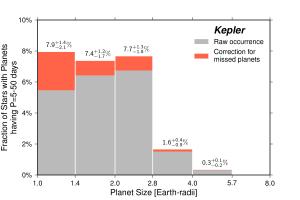Team of astronomers find planets the size of Earth are common
University of Hawaiʻi at MānoaEditor and Media Contact, Institute for Astronomy
Dr. Andrew Howard, (808) 956-8637
Assistant Professor, Institute for Astronomy
A team of astronomers from the University of California, Berkeley and the University of Hawaiʻi at Mānoa has found that 17 percent of all sun-like stars have planets 1 to 2 times the diameter of Earth in close orbits. The finding, based on an analysis of the first three years of data from NASA’s Kepler mission, was announced today at the American Astronomical Society meeting in Long Beach, California.
While other studies had shown that planets around stars are common in our galaxy, until this study, it remained unclear if this is true for Earth-size planets.
The team consists of UC Berkeley graduate student Erik Petigura, former UC Berkeley postdoctoral fellow Andrew Howard, now on the faculty of the UH Mānoa Institute for Astronomy, and UC Berkeley professor Geoff Marcy.
To find planets, the Kepler space telescope repeatedly images 150,000 stars in a small region of the sky. It looks for a tiny dip in each star’s brightness that indicates a planet is passing in front of it, much like Venus passed between Earth and the sun last summer.
The team’s estimate includes only planets that circle their stars within a distance of about one-quarter Earth’s orbital radius – well within the orbit of Mercury – which is the current limit of Kepler’s detection capability. Further evidence suggests that the fraction of stars having planets the size of Earth or slightly bigger orbiting within Earth-like orbits may be as high as 50 percent.
Planets 1 to 2 times the size of Earth are not necessarily habitable. Painstaking observations by the team show that planets two or three times the diameter of Earth are typically like Uranus and Neptune, which have a rocky core surrounded by helium and hydrogen gases and perhaps water. Planets close to their stars may even be water worlds – planets with oceans hundreds of miles deep above a rocky core.
Nevertheless, planets between one and two times the diameter of Earth may well be rocky and, if located within the Goldilocks zone – not too hot, not too cold, just right for liquid water – could harbor life.
“Kepler’s one goal is to answer a question that people have been asking since the days of Aristotle: What fraction of stars like the sun have an Earth-like planet?” said Howard. “We’re not there yet, but Kepler has found enough planets that we can make statistical estimates.”
Howard added, “Our key result is that the frequency of planets increases as you go to smaller sizes, but it doesn’t increase all the way to Earth-size planets – it stays at a constant level below twice the diameter of Earth.”
The estimates are based on a better understanding of the percentage of big Earths that Kepler misses because of uncertainties in detection, which the team estimates to be about one in four, or 25 percent.
For planets as large as Jupiter, the star may dim by 1 percent, or one part in a hundred, which is easily detectable. Petigura added that a planet as small as Earth, however, dims the star by one part in 10,000, which is likely to be lost in the noise. The software used by the Kepler mission is not optimized for finding these planets, so Petigura spent the past two years writing a software program called TERRA, for Transiting Exoearth Robust Reduction Algorithm. The UC Berkeley/Hawaiʻi team then fed TERRA simulated planets to test how efficiently the software detects Earth-size planets.
“It may seem crazy to spend two years redoing what the Kepler team has already done, but the question we are asking – How many Earth-size planets are we missing? – is so important that we wanted to do it separately for cross-validation,” said Petigura.
An analysis of three years of Kepler observations identified 119 Earth-like planets ranging in size from nearly six times the diameter of Earth to the diameter of Mars. Thirty-seven of these planets were not identified in previous Kepler reports.
While these planets were detected by the spaceborne Kepler Telescope, Howard and colleagues also used another telescope closer to home: the mighty Keck I Telescope on Mauna Kea on the island of Hawaiʻi. These supporting Keck observations were used to characterize the host stars of the newly discovered planets and to rule out any false planet detections from Kepler.
The analysis confirmed that the frequency of planets increases as the size decreases, which Howard and the Kepler team reported last year. Perhaps 1 percent of stars have planets the size of Jupiter, while 10 percent have planets the size of Neptune. Marcy compared this to rocks on a beach – large boulders are rare, stones are more common and pebbles extremely abundant.
Unlike the beach, where sand grains and flecks are even more abundant, they now estimate that the abundance of planets stops rising at about twice Earth’s diameter and remains the same until the size of Earth, the limit of their analysis. This corrects an impression left by Howard’s earlier paper that the frequency of Earth-size planets actually decreases below twice Earth’s diameter.
“A year ago, Kepler had found only a few planets smaller than twice Earth’s diameter, far fewer than would be expected if you extrapolate downward from the abundances of larger planets,” said Petigura. Accounting for planets that Kepler misses still means that big Earths are one-third as abundant as would be expected if the rising trend continued below twice the diameter of Earth.
Howard noted, however, that if 17 percent of all stars have big Earths within the orbit of Mercury, “where are they in our solar system? Maybe our solar system is an anomaly compared to the great variety of stars.”
Petigura’s work was supported by a National Science Foundation graduate student fellowship.
For more information, visit: http://www.ifa.hawaii.edu/info/press-releases/EarthSizePlanets/

